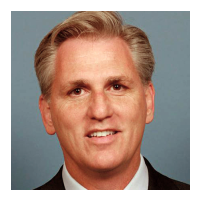GOP House Leader from Polluted-Bakersfield Leads Fight for Dirtier Air
 House Majority Leader Kevin McCarty
House Majority Leader Kevin McCarty
Newly-minted House Majority Leader Kevin McCarthy (R-Bakersfield) knows something about air pollution. A decade ago, his part of California averaged 153 bad ozone days a year and, while improved by force of regulation, it’s still the worst in the state. He’s averse to changing that situation in the near future.
McCarthy, who was promoted from whip this year when Eric Cantor lost his House seat, vowed to do what he could to thwart a new, stronger standard proposed by the U.S. Environmental Protection Agency (EPA) for reducing smog-producing ozone. Ozone is so geographically problematic in California, the federal government has a given the state a longer timeline to meet the standards.
In a statement, McCarthy called the Central Valley’s “cleaner air year over year” acceptable “progress.” But now, “EPA’s latest ozone regulation kicks the ladder out from underneath us.”
There isn’t that far to fall. San Joaquin Valley led the nation this year with 97 bad ozone days. If the new ozone standard were applied, the region would be out of compliance on 146 days. That’s not good. Ozone is hard on humans. It wrecks their lungs, wreaks havoc with asthmatics and has been linked to nervous system disorders and heart ailments.
There may be some disagreement about how low the particulate count has to be before people can breathe easy, but the consensus is we’re not there yet. The only question is do we want to pay the price to go lower.
The EPA is required by the Clean Air Act to review ozone emission standards every five years. It settled on 75 parts per billion (ppb) in 2008, the last year of the Bush administration, although an EPA science advisory group recommended 60-70. Amid court challenges, the EPA was prepared to release a lower standard in 2011. But President Obama, locked in a re-election campaign, delayed the move, citing the cost and its burden on business.
More lawsuits followed and a court gave the EPA until December 1 to release the new rule. They settled on a range between 65 and 70 ppb depending on certain circumstances, but left open the possibility of revising it down to 60.
The EPA estimates that getting down to 65 ppb would cost business $15 billion annually by 2025 and just $3.9 billion if the standard is 70. That cost omits California, which is considered separately. A 70 ppb standard would cost $800 million, and 65 would cost double that.
But going to 60 ppb could be another story. The National Journal says EPA cost estimates range between $19 billion and $90 billion a year, while the National Association of Manufacturers (NAM) calculates the price of apocalypse at $270 billion a year by 2017.
The EPA figures the costs at 65 and 70 ppb are balanced off by societal savings. Healthier people would save the economy between $6.4 billion and $13 billion at 70 ppb and $19 billion to $38 billion for 65 ppb. Society would also save a lot of suffering. Strengthening the standard would prevent from 320,000 to 960,000 asthma attacks and from 330,000 to 1 million missed school days by children annually. Missed workdays would be reduced by 65,000 to 180,000 and there would be between 750 and 4,300 fewer premature deaths.
McCarthy’s opposition to the EPA standard was echoed throughout the GOP hierarchy. Republicans are taking over the Senate and Senator Jim Inhofe (R-Oklahoma), a vociferous climate-change denier, will become chairman of the Senate Environment and Public Works Committee. The ultra-conservative U.S. Supreme Court is business friendly and the surging GOP is one presidential election away from controlling all levers of the federal government.
Voters in Bakersfield and Congressional District 23 might be close to getting the kind of air they voted for.
–Ken Broder
To Learn More:
California's Ozone Limits Just Aren't Enough, EPA Says (by David Danelski, Orange County Register)
With Proposed New Ozone Rule, Obama Tees Up Next Environmental Fight (by Jason Plautz, National Journal)
EPA Proposes to Tighten Ozone Emissions Standard (by Andrew Burger, Triple Pundit)
EPA's Proposed Ozone Limit Faces Political, Cost Hurdles (by Neela Banerjee, Los Angeles Times)
Valley Ozone at Record Low Levels . . . but (by Steven Mayer, Bakersfield Californian)
EPA Proposes Smog Standards to Safeguard Americans from Air Pollution (U.S. Environmental Protection Agency)
Obama’s Aggressive Environmental Agenda Relies on Powerful 1970 Clean Air Act (by Steve Straehley, AllGov)
- Top Stories
- Controversies
- Where is the Money Going?
- California and the Nation
- Appointments and Resignations
- Unusual News
- Latest News
- California Forbids U.S. Immigration Agents from Pretending to be Police
- California Lawmakers Urged to Strip “Self-Dealing” Tax Board of Its Duties
- Big Oil’s Grip on California
- Santa Cruz Police See Homeland Security Betrayal in Use of Gang Roundup as Cover for Immigration Raid
- Oil Companies Face Deadline to Stop Polluting California Groundwater





